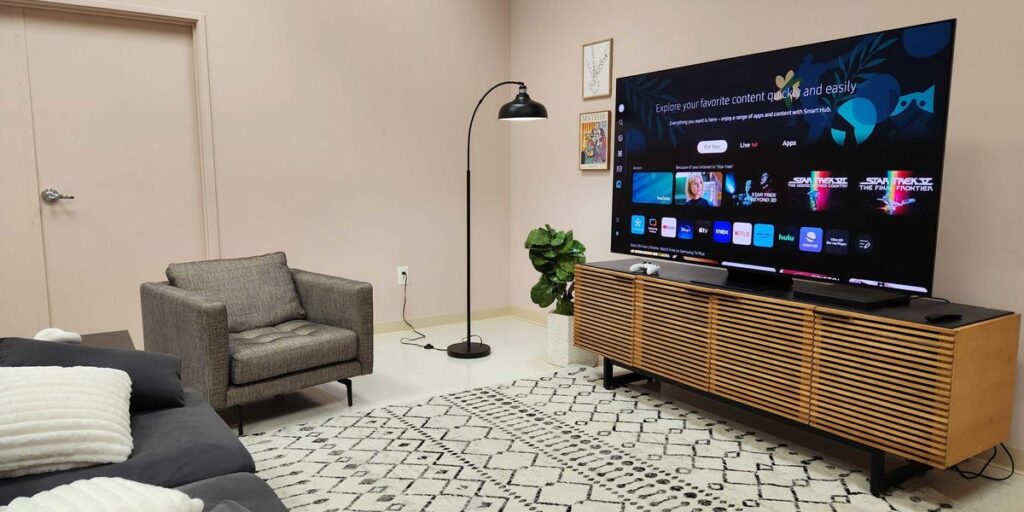When you buy through our links, Business Insider may earn an affiliate commission. Learn more
The best 4K TVs are smart, colorful, sharp, and reliable, enabling them to act as the entertainment center of any room for movies, shows, sports, and video games. But, while all 4K TVs offer an Ultra HD resolution of 3,840 x 2,160 pixels, overall picture quality can vary greatly between different models.
To help you find the right display for your needs, we picked the best 4K TVs you can buy in 2024 with image performance and general usability in mind. Our top recommendation, the Samsung S90C OLED, offers pixel-level contrast while delivering brighter colors than similar TVs from other brands. Buyers on a budget should consider the Hisense U6K QLED, the cheapest 4K TV we’ve seen with an advanced Mini LED backlight.
We also recommend top OLED models from Sony and LG, as well as picks geared toward midrange pricing and bright rooms. All of the displays listed below are sold in multiple screen sizes, and most retailers let you select different sizes from their listing pages.
Our top picks for the best 4K TVs
Best overall: Samsung S90C 4K TV – See at Amazon
Best on a budget: Hisense U6K 4K TV – See at Walmart
Best high-end OLED: Sony A95L 4K TV – See at Amazon
Best midrange OLED: LG C3 4K TV – See at Amazon
Best anti-glare display: Samsung S95D 4K TV – See at Amazon
Best high-end QLED: TCL QM8 4K TV – See at Amazon
Best midrange QLED: Hisense U7K 4K TV – See at Amazon
Best for wall mounting: LG G3 4K TV – See at Amazon
Best overall
Samsung S90C 65-inch 4K OLED TV
The S90C is our pick for the top TV you can buy right now. It delivers premium 4K image quality with high contrast and vivid quantum dot colors for less than similar OLEDs from LG and Sony.
The Samsung S90C delivers the best balance between picture performance and price of any 4K TV we’ve reviewed. The display uses an OLED panel with quantum dots, enabling an infinite contrast ratio, a wide range of colors, and a brighter image than direct competitors from LG and Sony.
OLED tech gives the S90C inky black levels and wide viewing angles, while the display’s use of quantum dots allows it to produce richer colors than a regular OLED. This makes the TV a great fit for dark home theaters and average living rooms. HDR (high dynamic range) movies and shows from 4K Blu-rays or streaming services like Prime Video and Disney Plus look especially stunning using the HDR10 and HDR10+ formats.
Smart TV features are also robust, with access to every popular app there is, along with Alexa and Bixby voice control. Though we wish navigation were a little smoother, the interface is solid, and it even includes a Gaming Hub that lets you access services like Xbox Game Pass to stream games without a console. And if you pair the TV with a gaming PC, it can support a smooth 144Hz refresh rate.
The only notable con is the TV’s lack of Dolby Vision support. Most Dolby Vision content will instead play in standard HDR10, which isn’t quite as precise, but the TV’s HDR10 performance is so strong that most people won’t notice a difference. Check out our HDR guide for more details on how Dolby Vision compares to other formats.
Though there are better-looking TVs on the market, including Samsung’s own S95C and S95D, they cost a lot more. There’s also a new 2024 version of this display, called the S90D, that can get a bit brighter, but again, it’s much more expensive than the S90C. With deal prices as low as $1,500 for the 65-inch model, the S90C is still the best 4K TV — and the best TV period — that you can get for the money.
Check out our Samsung S90C 4K TV review.
Note: The 83-inch version of the S90C does not use quantum dots, so its color performance can’t match that of smaller models.
Best on a budget
Hisense 65-inch U6K QLED 4K TV
Hisense’s U6K is one of the best budget TVs you can buy. The 4K display boasts quantum dots, local dimming, and a Mini LED backlight to deliver better contrast and color performance than most competitors in its price range. This isn’t the lowest price we’ve seen, but it’s still an incredible deal for a Mini LED TV.
The Hisense U6K is the best 4K TV for anyone who wants an affordable QLED display that doesn’t skimp on picture quality.
The TV uses quantum dots and full-array local dimming, which are features typically reserved for midrange and high-end display models. Even better, the U6K also uses a Mini LED backlight, which gives it better control over its light output. At a typical sale price of just $550 or less, the 65-inch U6K is the most affordable Mini LED TV we’ve ever seen.
The TV’s contrast performance isn’t on par with pricier QLEDs, and during testing, its black levels proved to be less deep than what we saw on Hisense’s step-up U7K or TCL’s high-end QM8. But that’s understandable, given the difference in cost. You still get a wide color gamut and up to 600 nits of brightness, which is enough to start seeing the benefits of HDR content. You even get Dolby Vision support to produce the most accurate HDR image the TV can produce.
On the downside, the display is limited to a 60Hz panel, so you can’t enable 120Hz support with a PS5 or Xbox Series X. Viewing angles aren’t great either, but they’re on par with what you can expect in this price range. And though the Google TV interface lags more than we’d like, it still performs well enough for a budget set.
If you want to dip your toes into the 4K HDR market, the Hisense U6K is a great entry-level choice. It’s affordable without sacrificing features that make a 4K HDR TV worth owning. Hisense does sell a new version of this TV for 2024, the U6N, but it currently costs a lot more and doesn’t offer a big upgrade.
Check out our Hisense U6K 4K TV review.
Best high-end OLED
Sony 65-inch A95L OLED 4K TV
Sony’s A95L is the best high-end TV you can buy. Though pricey, its QD-OLED panel delivers the most impressive picture quality we’ve seen. It’s also got a premium design and Google’s convenient smart TV interface.
If you want the best 4K TV for a high-end home theater setup, the Sony A95L OLED is the current champ. Like most competing OLEDs from Samsung, it uses an advanced panel with quantum dots to achieve a brighter picture with better color volume than a typical OLED.
We measured a peak of 1,500 nits on the A95L during our tests. That’s 50% brighter than Sony’s previous-gen A95K, making the A95L’s image really pop during scenes with especially bright highlights. Samsung’s brand-new S95D OLED can get a bit brighter with a peak of around 1,700 nits, but unlike the S95D, the A95L supports Dolby Vision and benefits from Sony’s proprietary picture processing to optimize its images and upscale lower-quality sources. The differences between the A95L and top OLEDs from Samsung and LG can be subtle, but Sony remains the leader in delivering the most accurate picture for the best movie-watching experience.
The A95L’s Google TV operating system also works well so that you can stream all your favorite services. A voice remote is included with Google Assistant voice control, and it has a handy backlight that turns on when you pick it up. The TV’s stand can even be set up in either a high-profile arrangement (if you want to put a soundbar in front) or a low-profile mode for a flush look on your entertainment console.
It’s expensive, but the Sony A95L OLED is the best 4K TV for high-end performance. Most people will be satisfied with something cheaper, like the Samsung S90C, but if you can afford it and want a premium TV that does it all, the A95L is the display to buy. The only notable downside is its lack of a 144Hz mode, but that feature only benefits dedicated PC gamers.
Best midrange OLED
LG 65-inch C3 OLED
The C3 delivers excellent contrast thanks to its OLED Evo panel, and unlike similarly priced Samsung OLED TVs, it supports Dolby Vision. This deal price matches discounts we’ve seen in the past.
Year after year, LG’s C-Series remains a top contender for the best 4K TV you can buy. And the C3 is no different. In fact, if it weren’t for the Samsung S90C’s competitive price, the C3 would likely earn the top spot on this list. While it lacks the quantum dot tech that gives Samsung’s OLED a boost in brightness and color volume, the C3 still delivers great picture quality and reliable smart TV performance.
Like all OLED displays, the C3 has an infinite contrast ratio with deep black levels that look fantastic when watching movies in a dark room. It also has wide viewing angles, so the image doesn’t distort or fade if you’re sitting toward the side of the TV. Peak brightness is solid for a midrange OLED, at around 800 nits, but it can’t match the 1,000+ nits that more expensive OLEDs can achieve.
On the plus side, the C3 does have one picture-quality perk that our top pick lacks: Dolby Vision support. Dolby Vision is regarded as the best HDR format since it can more precisely tell your TV how to display contrast and colors, and Dolby Vision is supported on tons of streaming services and 4K Blu-ray discs. We don’t consider this a must-have feature, but it is a nice inclusion.
LG’s webOS platform also provides easy access to popular apps, and the TV’s unique Magic Remote allows you to navigate menus by pointing at the screen to move a cursor.
Though we think the Samsung S90C’s image performance has an edge over the C3 at this price point, the C3 is an excellent alternative for buyers who prefer the LG brand or consider Dolby Vision essential. Shoppers should also note that LG now sells a 2024 version of this TV, called the C4. We got an early hands-on look at the C4, and it’s a great TV. However, it costs much more than the C3 and doesn’t offer a huge upgrade. As a result, we still recommend the C3 as the better value between the two.
Best anti-glare display
Samsung 65-inch S95D 4K OLED TV
This exceptional high-end TV is the brightest OLED we’ve ever tested. It features a new matte screen that nearly eliminates reflections, making it an ideal pick for bright rooms. However, the matte design does give black levels a somewhat faded look in direct light.
Samsung’s 2024 S95D is the brightest OLED TV we’ve ever tested. It also boasts an anti-glare screen with a matte finish to combat reflections better than any other display in this guide. These two qualities make it an ideal OLED for buyers who have bright rooms that are plagued by glare from windows and lights.
With the S95D set in Filmmaker mode (the TV’s most accurate picture preset), we measured a peak brightness of 1,700 nits. That’s 200 nits more than we measured on top OLED models from Sony and LG. Though the S95D can only sustain that number briefly before dimming significantly, most HDR highlights that need to get that bright (like an explosion) only appear on screen for quick flashes. As a result, we don’t consider this behavior to be a big deal.
In addition to delivering excellent HDR10 and HDR10+ performance with vivid colors and punchy highlights, the TV’s high brightness gives you more wiggle room to play with settings and adjust the display’s luminance to suit rooms that let in a lot of light. On top of that, the S95D is one of the few TVs you can buy that uses a matte screen instead of a glossy screen.
Though there are some key perks that come with glossy displays, they’re prone to showing lots of reflections in bright rooms. In contrast, the S95D’s matte finish essentially eliminates glare and reflections entirely. This makes it a game changer for people who struggle with reflections caused by lights from indoor sources and windows. However, there is one catch that comes with the matte screen: it hurts black-level performance in a bright room.
The S95D’s black levels in a dark room look just as deep and inky as they do on any OLED, but once you put the lights on, black levels become elevated with a more grayish and hazy look. This is particularly noticeable when you watch movies and shows with lots of dark scenes.
On the other hand, TVs with glossy screens are much better at preserving deep black levels in bright rooms, but the tradeoff is that you have to deal with more reflections and glare. Ultimately, whether you like the S95D’s matte screen comes down to personal preference and your priorities as a viewer, but if you want a display that almost completely eliminates pesky reflections and delivers high-end image quality, this is the best 4K TV to get. The only other notable TV on the market with a similar matte screen is Samsung’s Frame, but that model can’t match the S95D’s overall image performance and extra features, like 144Hz gaming support.
Check out our Samsung S95D 4K TV review.
Check out our guide to the best Samsung TVs.
Best high-end QLED
TCL 65-inch QM8 QLED 4K TV
TCL’s QM8 is its latest flagship 4K QLED TV. It offers excellent contrast and brightness with a Mini LED backlight and up to a 144Hz refresh rate for a great price. Right now, it’s more affordable than ever, with this price drop matching the previous all-time low.
TCL’s QM8 4K TV is one of the most impressive QLED models you can get, and it costs less than competing high-end options from brands like Samsung. The display produces a peak of around 2,000 nits when set in its most accurate picture mode, which enables it to deliver stunning HDR performance, even in bright rooms.
Thanks to its Mini LED backlight and full-array local dimming capabilities, the QM8 can also maintain excellent control over its light output across more than 1,000 zones on its screen. This results in deep black levels, and we didn’t see any large halos around bright objects during our review. But despite its high number of dimming zones, contrast control still can’t match the pixel-level precision of an OLED.
This is especially true if you watch TV from an off-center position. Viewing angles are lacking, so contrast fades, and color accuracy distorts if you sit to the side of the display. The TV’s anti-reflective coating also has a side effect that’s worth noting. While the QM8’s high brightness allows it to perform exceptionally well in rooms with a lot of ambient light, the panel can exhibit a rainbow-streak effect when reflecting certain overhead lights. Samsung’s similarly bright QN90C QLED TV doesn’t have this issue, but it costs at least $600 more.
Gamers will find all the latest features, including support for a fast 144Hz refresh rate when paired with a PC. And like most TCL models, the QM8 uses the Google TV interface and includes a Google Assistant voice remote. We encountered smooth navigation during our review and noticed slightly snappier performance than the competing Hisense U8K provides.
That said, we ran into a strange WiFi error several times during testing. The TV would often display a “WiFi Not Connected” message despite no problems with our connection. This seems to be an isolated glitch with our internet setup, however, so we don’t expect it to be a recurring issue for most buyers.
Check out our TCL QM8 4K TV review.
Best midrange QLED
Hisense 65-inch U7K QLED 4K TV
The Hisense U7K delivers great picture performance for its class, with excellent HDR brightness and advanced gaming features.
The Hisense U7K delivers performance on par with many displays that cost quite a bit more, making it one of the best 4K TVs you can get for under $800. Like the cheaper U6K, this display uses a QLED panel and a Mini LED backlight for precise local dimming and contrast control. But this model has a higher peak brightness of 1,000 nits, and we saw noticeably richer black levels during our tests.
Of course, you get tradeoffs with a midrange set, but the U7K impresses for the money. Though brightness can’t match more expensive QLED TVs like TCL’s QM8, the U7K has good HDR performance and supports all major formats, including Dolby Vision.
On top of that, the TV has a 120Hz panel with HDMI 2.1, so it can support advanced gaming features when paired with a PS5 or Xbox Series X. Its refresh rate can even go up to 144Hz if you pair it with a compatible gaming PC. The display’s Google TV platform can lag a little, but you still get access to every app you could want, along with Google Assistant voice control.
The 65-inch model is often on sale for as low as $680. The U7K delivers unmatched value at that price. You’ll need to pay more if you want something brighter and with wider viewing angles, but if you’re looking for a solid home theater display that has great gaming performance without breaking the bank, the U7K should be your top choice. Hisense does sell an updated version of this TV with an even brighter panel, called the U7N, but we think the cheaper U7K remains a better value overall.
Check out our Hisense U7K 4K TV review.
Best for wall mounting
LG 65-inch G3 OLED 4K TV
The G3 uses new micro-lens array technology to get brighter than most other OLED TVs while still offering perfect black levels. It also has a thin “Gallery” design that makes it ideal for mounting on your wall.
LG’s G3 OLED is specifically designed to hang flush on your wall with virtually no gap. It features a thin design measuring just under an inch and looks beautiful when wall-mounted. The G3 serves as the successor to the LG G2 OLED, and while that model was already stellar, the G3 offers a nice jump in brightness.
Though there are OLED TVs with thinner profiles, like the Samsung S95D, that display requires a separate connection box to house its ports and processing components. The G3 maintains a slim design while keeping everything within the TV’s cabinet.
And thankfully, the display’s picture performance is just as impressive as its elegant styling. The panel doesn’t use quantum dots like Sony and Samsung OLEDs but uses “Micro Lens Array” (MLA) technology to produce similar peak brightness levels. We measured a peak of around 1,470 nits, just under the highest measurement we got with the Sony A95L. On the downside, the G3’s lack of quantum dots does mean that color volume isn’t as high as what you’d get on the A95L or Samsung’s OLEDs.
It’s also important to note that the G3 is built with wall mounting in mind. So much so that it doesn’t even come with a traditional TV stand. You can buy one separately, but that adds to the cost, and we don’t love how the screen tilts back slightly when placed on the stand.
However, LG does have a new 2024 edition of this display, called the G4, that now includes a stand with the 55- or 65-inch options. And this new stand doesn’t cause the TV to tilt back. We got an early hands-on look at the G4, and it’s a gorgeous display, but it only has minimal performance improvements over the G3. If you plan to wall mount your TV, the cheaper G3 remains a better buy.
How we test 4K TVs
We evaluate several key factors to test TV models for consideration in our guide to the best 4K TVs, including picture clarity, high dynamic range (HDR) performance, color gamut, contrast, viewing angles, smart TV capabilities, navigation speed, and value.
We use an X-Rite iDisplay Plus colorimeter with test patterns found on the Spears & UHD HDR Benchmark 4K Blu-ray to measure a TV’s brightness and color capabilities.
We also use a series of demo scenes and real-world content to evaluate each TV’s overall picture quality, with a specific focus on scenes that emphasize black levels, specular highlights, color fidelity, and sharpness with native 4K, high-definition (HD), and standard definition (SD) material via cable, Blu-ray players, and all of the best streaming services. TVs are also evaluated in different viewing conditions, including a completely dark room for critical movie watching and environments with various lights on and sunlight let in through windows to test daytime performance and reflection handling.
Smart TV functionality is also considered, with tests to measure how long apps take to launch and how smooth menu navigation is. We also evaluate voice search responsiveness and digital assistant capabilities.
4K TV FAQs
Are 2024 4K TV models worth it?
New 2024 4K TV models from brands like Samsung, Sony, Hisense, and LG are now rolling out to stores. However, 2023 models will remain available throughout the year while supplies last.
Most 2024 TV models only offer modest performance upgrades, and their launch prices are much higher than what their 2023 counterparts currently sell for. There are exceptions, but generally, we think 2023 4K TV models remain a better value for most buyers.
What are the best brands for 4K TVs?
LG, Samsung, and Sony are among the top TV brands. Though typically more expensive than other options, these companies’ TVs are known for delivering cutting-edge technology, modern designs, and great quality control. If you’re in the market for a premium TV, you can’t go wrong with flagship models from these manufacturers.
Meanwhile, brands like TCL, Hisense, and Vizio are top midrange and value-priced TV market players. Though build quality isn’t always on par with more expensive brands, these companies offer advanced features, like quantum dots and Mini LED dimming, for less than the competition. If you want the best bang for your buck in a midrange TV, these are the brands you should consider first.
Companies like Amazon and Roku have also started manufacturing entry-level and midrange TVs with mixed results. Their flagship offerings are decent options when on sale, but you can typically find better displays for less money from TCL, Hisense, or Vizio.
Finally, budget brands like Toshiba and Insignia are known for selling entry-level LED displays that use Amazon’s Fire TV operating system. Though inexpensive, these sets are about as basic as TVs get. We typically recommend paying a bit more to get one of our picks for the best 4K TVs listed above, but these displays are decent enough if you just want a cheap TV for casual viewing, especially in a smaller screen size.
What size 4K TV should I get?
What size 4K TV you should buy depends on how much space you have, how far you will sit from your display, and your budget. In general, bigger TVs cost more than smaller ones with comparable features, and you’ll need to have enough wall space or a large enough TV stand to accommodate whatever display you get.
TV sizes start as small as 24 inches and reach around 98 inches. A few manufacturers have premium models that are even larger. Many companies reserve their best picture quality and design features for their bigger sizes. Though not a hard rule, midrange features are often reserved for models that are 50 inches or larger, and high-end features tend to start in 55-inch models.
Most companies use 65 inches as their flagship size to highlight their best 4K TVs, and for many people, 65 inches hits just the right sweet spot to offer a solid home theater experience without taking up too much real estate or totally breaking the bank.
If space and budget aren’t a concern, what size 4K TV you should get can be best determined by how far you plan to sit from your display. This is because the benefits of 4K resolution become most noticeable when you sit at a distance of about one to 1.5 times the size of your TV. For instance, to get the most out of a 65-inch 4K TV, you should sit between 5.4 and 8.1 feet from your TV. Crutchfield has a handy chart recommending 4K TV sizes based on your seating distance.
For 4K TV recommendations tied to certain sizes, check out our size-specific guides:
What are the best smart TV interfaces?
Practically any new 4K TV you buy will be a smart TV, which means it features built-in support for accessing popular apps and streaming services. However, different companies use different smart TV interfaces. Here’s a rundown of the different platforms that each brand uses.
- Tizen: Samsung
- webOS: LG
- SmartCast: Vizio
- Google TV: Sony, TCL, Hisense
- Roku TV: Roku, TCL, Hisense
- Fire TV: Amazon, Toshiba, Insignia, Pioneer, Hisense
Though a few services may be missing here and there, all major streaming players are supported across every platform. However, each system’s navigation style, personalization options, and extra features differ.
We prefer Roku’s interface for being the simplest, most user-friendly, and most reliable of the bunch, but its visual style is a bit outdated compared to other operating systems that present a more content-focused approach. Ultimately, every system has pros and cons, but they all get the job done.
If you’re unhappy with your TV’s built-in interface, you can purchase a separate streaming device with your preferred platform. Roku and Fire TV options are often sold for as low as $20. Check out our guides to the best streaming devices and best Fire TVs for more details.
What’s the difference between OLED and QLED?
OLED and QLED TVs are two of the most popular display types on the market, and they each have their own pros and cons.
OLEDs have self-illuminating screens. This means they can precisely dim and brighten each pixel to create an infinite contrast ratio. This makes OLED the ideal choice for people who want the absolute best image quality, especially if you like watching movies in a dark home theater.
QLED TVs, meanwhile, are a type of LED TV that relies on older LCD panel technology that requires a backlight to illuminate their pixels. These backlights can include multiple zones to brighten and dim specific areas, but even the most advanced QLED models can’t match the pixel-level contrast of an OLED. This can cause an uneven look in dark scenes where you can see halos around bright objects or washed-out black levels that look gray.
Where QLED TVs have an edge, however, is with max brightness. Midrange and high-end QLED TVs can get brighter than most OLEDs. QLED models also tend to be less expensive than OLED TVs, and they present no risk for burn-in. For more details on the differences between each panel type, check out our QLED vs. OLED comparison.
What is burn-in?
Even the best OLED TVs are technically susceptible to an issue called burn-in. If a static image is left on the screen for hours on end — the CNN or ESPN logo in the corner, for example — a faint, ghostly image can get left stuck on the TV.
Though OLED owners should be aware of this risk, OLED TVs have specific measures built-in to prevent burn-in, including pixel-refreshers and pixel-shift modes. Publications like Rtings have conducted long-term tests with OLEDs, and while their results do show that burn-in is possible, their tests show that people with regular viewing habits don’t need to worry about it.
I’ve owned an LG CX OLED TV for over two years, and the display has no signs of burn-in. Though burn-in is something that QLED TV owners don’t have to think twice about, in my experience, as long as you don’t plan on watching CNN all day long, burn-in shouldn’t be a factor when deciding whether to buy an OLED.
Read the full article here
















